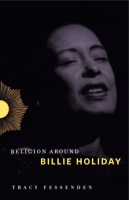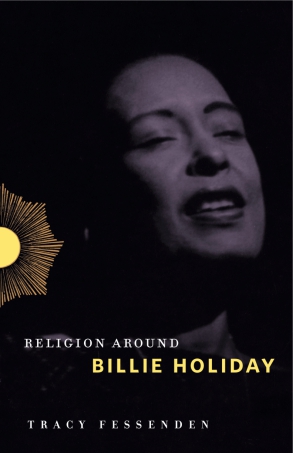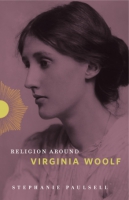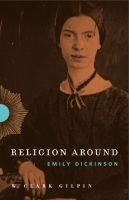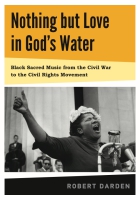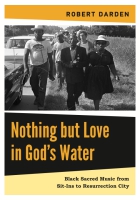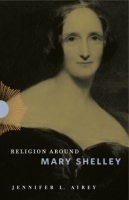Religion Around Billie Holiday
Tracy Fessenden
“A focused, enlightening examination of the gifted singer.”
- Description
- Reviews
- Bio
- Table of Contents
- Sample Chapters
- Subjects
Mixing elements of biography with the history of race and American music, Tracy Fessenden explores the multiple religious influences on Holiday’s life and sound, including her time spent as a child in a Baltimore convent, the echoes of black Southern churches in the blues she encountered in brothels, the secular riffs on ancestral faith in the poetry of the Harlem Renaissance, and the Jewish songwriting culture of Tin Pan Alley. Fessenden looks at the vernacular devotions scholars call lived religion—the Catholicism of the streets, the Jewishness of the stage, the Pentecostalism of the roadhouse or the concert arena—alongside more formal religious articulations in institutions, doctrine, and ritual performance.
Insightful and compelling, Fessenden’s study brings unexpected materials and archival voices to bear on the shaping of Billie Holiday’s exquisite craft and indelible persona. Religion Around Billie Holiday illuminates the power and durability of religion in the making of an American musical icon.
“A focused, enlightening examination of the gifted singer.”
“Fessenden’s work has significant value, particularly for the scholar invested in lived religion or the history of religion, jazz, and American popular culture.”
“It’s refreshing to read a nonfiction text so freewheeling, and to encounter a scholar who so delights in making observations for the sheer wit of them. Fessenden is interested in Holiday’s contemporaries and the coincidences of her career, and these aren’t artificially forced into an argument.”
“From first to last, the prose is consistently compelling, the insights sharp and often surprising. One comes away from this book knowing more about lots of things and admiring the seamless interweaving. It will be impossible to hear Holiday’s music the same way.”
“With beautiful prose and nuanced analysis, Fessenden navigates the reader through the religious landscape that shaped Holiday’s life and career and tunes our ear to listen for how the soundscape and spirituality of those religious sources shaped her artistry. What emerges is a rich and compelling portrait at the intersection of Holiday’s personal history, American Catholicism, blues and jazz culture, and the currents of race and gender in American life.”
“Illuminating, graceful, insightful, and bold, Tracy Fessenden’s marvelous interpretation of Billie Holiday is no mere biography. Religion Around Billie Holiday is an extension of, and improvisation on, the big questions shaping Fessenden’s work. Holiday is not only, in Fessenden’s imagination, an exemplary narrative subject. She also challenged the naturalization of American racial, gendered, and religious norms. Through her, Fessenden brilliantly shows us the fault lines in identity that were there all along, like more strange fruit.”
“A hungry, centrifugal curiosity animates Fessenden’s writing. At times, her sense of ‘religion around’ seems capacious enough to include nothing less than America itself. . . . The reward is richness of scope: every page brings a new tumble down another rabbit hole of twentieth-century American cultural history.”
“Joining Matthew J. Cressler’s important study of Vatican II and Black Power in mid-century Chicago with Authentically Black and Truly Catholic: The Rise of Black Catholicism in the Great Migration (New York University Press, 2017) is Fessenden’s towering close reading of an African American vocalist whose Catholic-informed life, and others’ memory of it, reflect her discursive and performative treatment as the patron saint of jazz.”
“Religion Around Billie Holiday is Fessenden's own performance of what listening around a life allows one to hear of religion and of America more broadly. She does it in a beautiful way.”
Tracy Fessenden is the Steve and Margaret Forster Professor in the School of Historical, Philosophical, and Religious Studies at Arizona State University and the author of Culture and Redemption: Religion, the Secular, and American Literature.
Contents
Acknowledgments
Introduction
1. Religion Around
2. True Confessions
3 The Story of Jazz
4. Crossing Jordan
5. Our Lady
Notes
Bibliography
Index
From the Introduction
In August 1977, a thirty-seven-year-old writer named Linda Kuehl arrived in Los Angeles from her native New York to interview Joan Didion for the Paris Review. Kuehl had published occasional pieces in the Paris Review and Commonweal and the literary sections of the New York Times, and she’d been at work on a biography of Billie Holiday for years. The interview took place in Didion’s light-bleached living room overlooking the sea. To escape the bright glare of the sun off the sea, those who sat and talked in this room, Didion said, tended to gravitate toward its dark corners. The published interview, culled from hours of taped conversation, opens in Didion’s voice. “It is usual for the interviewer to write this paragraph about the circumstances in which the interview was conducted,” Didion begins, “but the interviewer in this case, Linda Kuehl, died not long after the tapes were transcribed.” Kuehl’s intelligence and acuity, Didion says, had made her “relaxed and even enthusiastic about talking, which I rarely am.”
Kuehl had honed her skills in the scores of interviews she’d done by then with everyone she could find who’d known Billie Holiday and would talk on the record: accompanists, lovers, agents, friends, the undercover cop who fell half in love with her after tailing her for years, the Catholic priest in Harlem who said her mother Sadie’s funeral Mass. Nine days before the meeting with Didion, Kuehl’s editor at Harper & Row, Frances McCullough, wrote Kuehl to say she was dropping the Billie Holiday project. The book refused to cohere, McCullough said; the reader gets lost in choppy waters. “God knows,” McCullough wrote, “if it’s painful to me, it must be awful for you.” Maybe Kuehl shared the news in eliciting this comment from Didion: “I start a book and I want to make it perfect, want it to turn every color, want it to be the world.” But once begun, Didion went on, “I’ve already blown it, limited it, made it less, marred it. That’s very discouraging. I hate the book at that point.” But “maybe—if I go ahead and finish it anyway—I can get it right next time. Maybe I can have another chance.”
Kuehl never finished the Billie Holiday book; in February 1978 she saw Count Basie and His Orchestra perform at the Smithsonian in Washington, D.C., then returned to her hotel and, under psychic circumstances that remain unknowable, plunged to her death from a window. Years later, McCullough deposited a stack of Kuehl’s notes and draft chapters with the Institute of Jazz Studies at Rutgers University–Newark. In the drafts, McCullough’s editorial hand is heavy; paragraphs and pages are crossed out in bold slashes. Some of her queries to Kuehl are deflating. In a passage she’d revised and retyped many times, Kuehl writes, “It is interesting to speculate about the origin of Sadie’s Catholicism.” McCullough flags the sentence and puts a question in the margin: “Is it really?”
This book is a wager that yes, it is really; more, that the world Billie Holiday moved in was thick with religion of various stripes and degrees of remove from the pews, and that this religion mattered for her life and her sound and what she and others made of them.
Had Linda Kuehl continued to speculate on the origins of Holiday’s mother’s Catholicism, she would likely have turned up the record of Sadie Fagan’s commitment to the House of the Good Shepherd for Colored Girls in Baltimore, where she was sent at age thirteen to be “kept and detained” for five years. It was the same convent reformatory to which her daughter Billie, then Eleanora, was also sent by the courts, first when she was three months shy of ten and again two years later.
When she was not in the House of the Good Shepherd, Billie/Eleanora lived along the rough edges of a jazz-loving city with a shifting cast of mentors who catered to its hungers and pleasures. Holiday began her career in the Prohibition-era good-time houses on Baltimore’s waterfront, where she made money clipping johns and singing for tips. Childhood associates in Baltimore remembered that the “best-dressed hustlers used to come around the neighborhood to get Eleanora for the sing.” She’d sing to the accompaniment of records on the Victrola, a piano if there was one, or simply to the backup of the “singing on her mind.”
In her eleven months at the House of the Good Shepherd, Billie Holiday attended a compulsory Catholic Mass every day and sang every day from the forms set forth in the Liber Usualis, the common book of Gregorian chant used in the Mass, in daily and seasonal devotions, and in all feasts and celebrations in the liturgical year. It was a discipline at least as formative, one imagines, as Charlie Parker’s summer in the woodshed, playing scales. The Liber Usualis was revised in 1896 by the Benedictine monks of Solesmes, France, who sought a purer rendering of Gregorian chant’s rhythms and phrasing. Chant would still be sung sotto voce inside a minimalist melodic register, but no longer in weighty, metrical fashion. The Solesmes method liberated the singing of chant from a fixed beat in metronomic time, directing the “notes to be sung quickly and lightly” in the manner “of ordinary speech, or in unpredictable groups of two or three.”
The combined apprenticeships, convent and street, went to Billie Holiday’s distinctive undemonstrative cool, her soft parlando delivery of straight-up talk turned to song. “She had a whole way about her,” her accompanist Specs Powell recalled. “Tapped her foot very quietly, her head tilted slightly to the side. Nothing ever shocked her. She could say the most vulgar thing but never sound vulgar. She could curse a person out and still make it sound like music.” The hush-now shimmer of Holiday’s voice was made for the microphone, invented just in time for her arrival in Harlem at the end of the 1920s. Producer John Hammond caught her act at Monette’s Supper Club on 133rd Street and said he’d never heard a sound like hers, so different from the blues belters and corny band singers he knew. “Something must be done about her for gramophone records,” Hammond wrote of Holiday in his April 1933 column in Melody Maker, then put her in the studio with Benny Goodman to cut her first sides.
The record industry stayed alive in the Depression on the nickels fed to jukeboxes, and jukeboxes brought Holiday’s sound into towns where black women singers were known mostly as singers of gospel or blues. Neither blues nor gospel was Holiday’s element, but she could mine their characters and plots for some of the songs she wrote (“God Bless the Child,” “Billie’s Blues”) and the stories she told or lived out in her life: the great-grandmother who couldn’t read or write but knew the Bible by heart; the flinty Baptist aunt she used to torture by singing blues; her abusive cousin Henry who became a preacher; the preacher she married, Louis McKay, a brute the likes of any blues song’s baddest man.
Religion Around Billie Holiday is not a brief for Holiday’s piety or impiety, her importance to religious history, or her prophetic voice for civil rights. It is not a study of sacred themes in her work, for indeed Holiday recorded almost nothing that could be called religious. There’s the slyly ersatz spiritual “God Bless the Child”; a bootleg version of “My Yiddishe Momme” that showed up on a 2010 pressing of Jewish classics; and the rumor of “O Come All Ye Faithful” on a flimsy laminate disk she made in a coin-operated Voice-O-Graph booth, now a collector’s holy grail. She copyrighted a song she wrote about Louis McKay, “Preacher Boy,” but never bothered to record it. Religion Around Billie Holiday focuses not on Holiday’s religious practice or expression but rather on the environing religious conditions to which her genius responded, and in which her life and sound took form.
The spiritual weather through which Billie Holiday moved and still moves (as sound, image, words, memory, desire) was made in the colliding pressure systems of multiple religious formations: the urban, pre–Vatican II Catholicism that undertook to reform her; the theologies, politics, spaces, and sounds of the Afro-Protestant churches to which she never belonged; the vigilante faith that passed for justice in the gallant South; the vaporous, shape-shifting Jewishness of the American songbook; the gravitational pull of her contemporaries’ eclectic religious orbits; and the mytho-poetic charge of her own luminous iconicity.
In Holiday’s lifetime, and certainly by the 1950s, America’s religious climate might register as a well-behaved pluralism, Protestant- Catholic-Jew, the nation scrubbed and made prosperous by its citizens’ investments in one spiritual tradition or other. As Dwight D. Eisenhower famously remarked, “Our form of government has no sense unless it is founded in a deeply felt religious faith, and I don’t care what it is.” But the firmament flickered with glints of a different dispensation. A year after Billie Holiday’s death, Norman Mailer covered the 1960 Democratic National Convention for Esquire. The magnetism of Eisenhower’s obliteratingly charismatic successor, Mailer supposed, had something to do with music. For all his “good, sound, conventional liberal record,” John F. Kennedy had “a patina of that other life, the second American life, the long electric night with the fires of neon leading down the highway to the murmur of jazz.” The murmur of jazz was the shush of a spiritual current that ran crosscuttingly beneath America’s dull and necessary civic faith, “a subterranean river of untapped, ferocious, lonely and romantic desires, that concentration of ecstasy and violence which is the dream life of the nation.”
Religion Around Billie Holiday focuses broadly on the vernacular rituals and devotions that scholars have come to call lived religion—the Catholicism of the streets, the Jewishness of the stage, the Pentecostalism of the roadhouse or the concert arena—but not at the expense of more official religious forms and pronouncements in hierarchies, institutions, hagiographies, doctrines, and hymns. The secular habitations of Billie Holiday’s life and art, far from being spaces swept clean of religion, are where the worldly and the sacred trade riffs and skin: a Gershwin tune might clip a melody from synagogue chant, then slip into a jazz Mass by Mary Lou Williams. What Billboard first christened “rock and roll” were the Holy Roller hymns of gospel legend Sister Rosetta Tharpe. When Hollywood mogul Samuel Goldwyn made a film of the life of Saint Thaïs, the penitent libertine held up as a model for inmates of the House of the Good Shepherd, the board of censors insisted that he cut more than a dozen scenes from the theatrical release, including a stabbing, a suicide, several episodes of intoxication, and sex in various configurations and degrees of explicitness.
To consider religion around is to pay attention to ambient feeling and mood, to energies, pressures, frequencies, powers. While there is no sequestering of religion in favor of “spirituality” in this project, Religion Around Billie Holiday seeks neither to silence the witness of unquiet spirits, nor to suppress the vague and tricky category of the spiritual itself. “Sound and spirits both spill beyond whatever formulation we can momentarily give to them,” Jason Bivins writes, “carried away on the breath—the inspiration—that creates and steals them both as soon as, as sure as they’re born.” What Bivins recognizes as the “unnamed surplus” of spiritual energies surrounding jazz feels especially dense around Billie Holiday, who was so careless of all that bound her to the flesh, and whose appearances had for so many the quality of a visitation. The haunting timbre of her voice set poets to trying to name it. “The distress we feel in your presence,” Charles Henri Ford wrote in his 1946 “Chanson pour Billie,” “is like hearing footsteps that / will take us away.”
(Excerpt ends here)
Mailing List
Subscribe to our mailing list and be notified about new titles, journals and catalogs.
